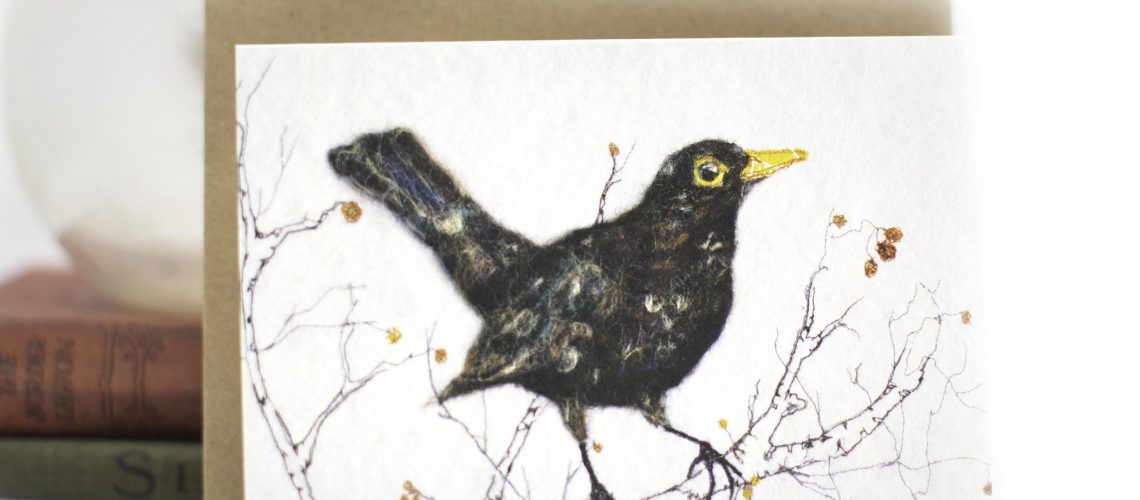This has been the winter of the blackbird. I haven’t been out and about much for one reason or another but I seem to be seeing and hearing blackbirds wherever I go.
I haven’t seen a redwing or a fieldfare yet, maybe they’re not around, or maybe I need to get out more. Well, that’s definitely true, I do need that.
And yes, when I’m putzing around the garden, doing a bit of tidying or what have you, the indomitable and loyal robin is the one who’ll come close, nosing and hopping about to see what’s what. And I heard a robin singing when I was down with Pad in his forest last week – no sound of robin’s lovely melancholy song around home yet. The robin remains the iconic winter bird, with his (or her, unusually for birds, male and females look quite similar) red breast and his dainty little body and his sharp eye.
Amazingly, a wren was singing up a storm on top of a telephone pole on our street before Christmas. Fair bowls to him. God loves a trier and it was probably to ward off some other male and not to entice an oul’ doll to snuggle up with him in whatever cave he’s found to hide away from the cold.
While I have heard the blackbird, it’s only been the rather melodramatic warning call, especially at dawn or dusk. Its like a manic ‘chak ack ack ack ack’ sound, rising to a crescendo, as it flies off crazily, just because one walked within twenty feet of it. And you always hear it going away from you, never towards. Bit of a drama queen, the blackbird, if you ask me.
The robin’s warning call is much more tempered, more like a ‘tit tit tit tit’, although you wouldn’t want to cross one of those boys, they’d go through you for sport, would the robin. Tough as nails, the robin, he’d face a regiment.
It all started (the blackbird bit) when we went to a craft fair in the Glucksman in November and I bought a lovely blackbird mug and Christmas cards from Molly Ellis of Ewe Sir Crafts. She makes a beautiful wool or felt-like image of the bird and it gives a fine texture. She told me that the blackbird was known as the ‘guardian of the household’ – which I never knew.
And of course most of the blackbirds around this time of year are immigrants down from Scandanavia to flee the cold. And they’re most welcome, all these black immigrants (haha) adding a bit of colour (haha) to our gardens and fields and hedges.
Speaking of colour, the males are obviously more interesting (of course they are), with their yellow beaks and eyes. To me the beak seems more orange or amber than yellow and the strength of colour is a big deal when attracting females or warding off other males.
I’ve gotten up close to a few this year as they come near to the window where I’ve been reading a lot and they can’t see through. Their eyes really are remarkable, the big black shining iris with the narrow bright yellow eye-ring.
Another feature I’ve noticed is the sheer vehemence with which they dig for worms. They throw back their heads and hop off the ground, giving a massive purchase to the jab and they usually stab at the earth a few times, quickly. God, if you ever got a head butt with that force, you’d have a broken skull.
I recommend watching birds, especially if you’re a writer. When Margaret Atwood was asked why she likes to watch birds, she said: “On the level of knowledge: An involvement with birds is a reliable hook into the state of the planet. (Hint: we’re not doing so well.) On the personal level: Watching birds takes you out of yourself. It’s a flow state. Writing ideas come in sideways during such states. So perhaps it is a form of meditation.”
A form of meditation indeed. I’m not one for seeking out new birds (a birder) to tick off, but whenever I see a bird, or hear one, I try to pay attention. They’re older than us, and were here before us, and our ‘pets’.
There were little grebes and tufted ducks down at the Atlantic Pond yesterday, diving away. And the gulls were standing on thin sheets of ice.
Unfortunate Latin name, the blackbird, given it’s part of the thrush family: turdus merula. The turdus is of the thrush family, the merula is blackbird. Hence the French name, merle. And it’s often mistaken with the ring ouzel; ouzel being an old name for blackbird too.
Shakespeare used it – of course he did – in A Midsummer Night’s Dream with the unforgettable lines of the unforgettably named Bottom: “The Woosell cocke, so blacke of hew, With Orenge-tawny bill”.
And the status of the bird this winter was copper-fastened when, a few weeks ago, I heard my hero, the great Robert Macfarlane (author of the imperious The Wild Places) in a podcast quote the equally great J.A. Baker (author of the imperious The Peregrine – fifty years old now, imagine), who, when describing a blackbird, used the immortal simile, that the bird looked ‘like a mad puritan with a banana balanced on its nose’.
Enough said.
Let’s hear it for an lon dubh: the blackbird.
Image by Molly Ellis, of Ewe Sir Designs

